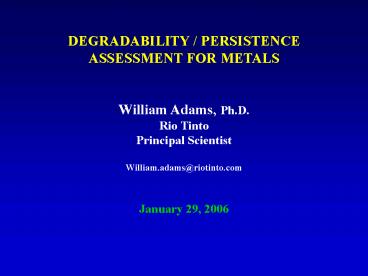DEGRADABILITY PERSISTENCE
1 / 25
Title: DEGRADABILITY PERSISTENCE
1
DEGRADABILITY / PERSISTENCE ASSESSMENT FOR
METALS William Adams, Ph.D. Rio Tinto Principal
Scientist William.adams_at_riotinto.com January
29, 2006
2
Degradability / Persistence
- Metals are commonly thought to be inherently
persistent - Why..
- They are elements
- The law of conservation of mass indicates this is
a logical conclusion - - mass cannot be destroyed or created
- But .. this does not consider the
toxicologically relevant metal form which can
change
3
Degradability / Persistence
Alternative definition for metals
Persistence is a property of a metal whereby
it remains in a bioavailable form in an
environmental media. Adams et al. 2000,
Hum. Ecol. Risk Assess. 6(1) 1019-1038
4
Degradability / Persistence
- Key Question
- What properties can be measured
- to assess persistency of metal ions in
- aquatic ecosystems?
- How do we use degradability data in assessing
- chronic II, III and IV (R53) (safety net)
5
Degradability / Persistence
GHS 4.1.2.10.1 For inorganic compounds and
metals, the concept of degradability as applied
to organic compounds has limited or no meaning.
Rather, the substance may be transformed by
normal environmental processes to either
increase or decrease the bioavailability of the
toxic species. 1. GHS Footnote 1 Specific
guidance will be provided by the agency on how
these data for such substances may be used in
meeting the requirements of the classification
criteria.
6
Degradability / Persistence
- For Classification the water column
- is the relevant medium
- Residence time in the water column
- Transformation to a non-bioavailable
- form
- - Complexed metal
- - Change of form and bioavailability
7
Free Metal Ion Concentration
Free Metal Ion (Fraction) pH 6.0 0.94 0.91 0.77
0.68 0.71 0.70 0.06 0.01 3.4 x 10-4 7.9 x
10-5 9.0 x 10-8 1.6 x 10-9 2.7 x 10-11
Metal Manganese Cadmium Cobalt Nickel Z inc
Iron (II) Lead Copper Beryllium Aluminum
Chromium (III) Mercury Iron (III)
Calculated using WHAM, i.e., BLM approach DOC
2 mg/L
8
Loss of Metal from the Water Column
- Consider the following
- Partitioning to solids and
- biota resulting in a significant
- reduction in exposure
- 2. Precipitation
9
(No Transcript)
10
(No Transcript)
11
Relationship between residence time and sorption
to solids
12
Loss of Metal from the Water Column
Continued - Consider the following 2.
Precipitation and sedimentation - iron as an
example
13
Loss of Metal from the Water Column
- Iron Sulfate
- Reviewed for aquatic classification
- Decision - acute
- Toxicity studies showed the
- acute LC50 values as gt10 mg/L
- Hence, R 52 but
14
Loss of Metal from the Water Column
- Iron Sulfate
- Decision - chronic
- Chronic NOECs gt 1 mg/L
- Half life in the water column at
- Relevant pH values lt1 day
- Consequence
- Iron and its compounds are not
- Classified for aquatic toxicity
- - R 52 does not stand alone
15
Loss of Metal from the Water Column
- Ferrous sulphate (Fe) oxidizes to Fe
- and forms ferric hydroxide Fe(OH)3
- precipitate
- Iron hydroxide is well known to not be
- soluble in water
16
Loss of Metal from the Water Column
General reaction of iron sulfate and water 2FeSO4
(aq) 1/2O2 3H2O FeOOH 2H2SO4
- The extent of the hydrolysis is rapid and
dependent on pH - Alkaline conditions encourage the reaction and
result in the - precipitation of iron (III) hydroxide
- Solubility limits for iron (Fe and Fe) (at
steady - state/equilibrium) would be expected to be
less than 1 mg/L. - This significantly reduces Fe water
concentrations - Lower pH levels keep ferrous sulphate in
solution - (100 fold from pH 6 to 8 .
17
Loss of Metal from the Water Column
General reaction of iron sulfate and water 2FeSO4
(aq) 1/2O2 3H2O FeOOH 2H2SO4
- The above reaction is well known to
- control natural levels of iron in natural
- surface waters (lakes, rivers and estuaries)
- Iron hydroxide precipitation is a well
- Known approach for removal of metals
- (arsenic) from water by sorption and
- precipitation
18
Loss of Iron from the Water Column
Figure 1. Fe2t/Fe2o as a function of time
in 0.5 M NaCl, I 0.5 M, at pH 7.2 for loadings
of 1, 10 and 100 mg/L FeSO4(s)
19
Loss of Metal from the Water Column
Fe2t/Fe2o as a function of time in 10X
dilute OECD 203, I 0.00087 M, at pH 6 for
loadings of 1, 10 and 100 mg/L FeSO4
20
Transformation/Dissolution progress curves Iron
powders
21
Transformation/Dissolution Aluminium Powder lt10 um
22
Hazard Identification For Metals Metal Compounds
- Summary
- Persistency / Degradability
- Speciation, transformation and
- bioavailability of metal ions should
- be considered
- - that is, the persistency of the metal
- form needs to be considered
- - failure to do so results in significant
- errors in assessing metal hazard and
- risk
23
Hazard Identification For Metals Metal Compounds
- Summary
- Water
- Key parameters to measure are
- - Residence time in the water column
- - Bioavailability of metal ions in
- solution
- - solubility as a function of pH
24
Hazard Identification For Metals Metal Compounds
- Summary
- Application
- In the absence of chronic toxicity or
degradability - data Chronic II, III and IV is applied (GHS)
- Metal degradability can be evaluated for
determining - the need or lack of need for Chronic II, III,
IV (R 53)
25
Hazard Identification For Metals Metal Compounds
- Summary
- Application
- GHS refers to degradation as removal from the
water - column
- We propose to use removal from the water column
- (residence expressed as half life) as a means
to - assessing chronic classification, when
appropriate for - metals































